A Retrospective Demo Review by Kingston C. Rockwell (Uncommon)
Download here
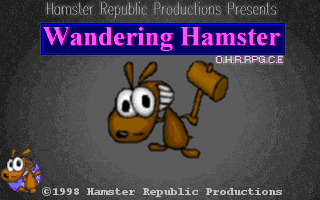
DON'T BE A MAN OR A MOUSE--
BE A HAMSTER!
Wandering Hamster
A Retrospective Demo Review by Kingston C. Rockwell (Uncommon)
Download here

DON'T BE A MAN OR A MOUSE--
BE A HAMSTER!
Wandering Hamster is one of those games that shouldn't require an introduction. For many of us, it was the first game we played on the engine. It was James' own little demonstration of what the engine could do. I don't know about anyone else, but I personally remember going back to it with each new engine update to see how Wandering Hamster implemented the new features. But without a progressive update in almost four years and the new release of Fenrir-Lunaris' WELCOME.RPG, Vikings Of Midgard, that purpose has kind've been outmoded, leaving the game to stand on its own, leading one to wonder, its importance aside, if James Paige were just any other OHRer, is this a good enough game it would still carry the same reputation?

By now, Bob the Hamster's story should be a familiar one. An adventurous young hamster stumbles upon a daring coup d'etat by a vile tyrant, and with help from his bubble mage friend, James, overthrows him, but that's hardly even the beginning! I'm not gonna give you a play-by- play here, you can play the game if you really want that. Instead, let me talk about what this game does, because I think that's way more impressive. Through its characters and their dialogue, Wandering Hamster conveys a sort of charm and humor that has become too rare in OHR games. A discouraging number of games either spend all their time taking themselves way too seriously or delve into an attempt at humor that's vapid at best. Bob, on the othe hand, has such an amusing naivete that's played to maximum effect in every encounter he has. And when the game isn't either adhering to or completely ignoring RPG traditions, you can bet it's parodizing them, the most memorable example being the plot- boulder-mover. With a lot of running gags, like Lord Hasim's godawful sense of castle decor, and the ominous potted cactus, the game's sense of humor will be the most effective hook in a plot that never seems like it's going in a specific direction (which is, if the outline over on the wiki indicates anything, not necessarily true; hints of where the game will end up do in fact exist in the demo). So, if you don't play it for anything else, you will at least get a few chuckles and enjoy the memorable characters.
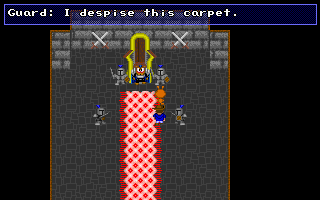
Now, it's true, the game has aged somewhat. It has some bugs exclusive to the soon-to-be-unsupported DOS version, and the music has a bad habit of dynamically changing its instrumentation after a battle ends (while going through Gallopeg Forest, I noted three distinct instrumentations), but none of this hides the fact that this is a highly playable game. The graphics are and always will be gorgeous. All throughout, from the exceptionally large-headed walkabouts to the map designs and tiles that make them up, the graphics carry such a heavy dose of character that few games pull off at that scale, and nothing else would quite work as well for this game, and even beyond that, they're pixeled very adeptly. As you move through, the transition between pixels and photoshop become more apparent, and while they still carry the same amount of character and charm, especially with the odder designs present in Gallopeg Forest, there always seems like something less magical about photoshopped work, like the veil's been pulled away. It's not necessarily a justified feeling, but it's a feeling that's present nonetheless. Beyond this, the game is always a beautful and eye-pleasing experience, especially with the panning introduction pictures.

The maps, well-constructed as has been mentioned, are often
sprawling.
You will not find it too hard to get lost in
Ixnekolan, which makes for a visually impressive experience. I especially
liked the way the shadows played off the arches in that city, though
these large maps can sometimes hit on the nerves, especially on a map
with a lot of battles. This was a small problem in Flanat village, but
much more so in Broaste Castle, where even though the rooms don't seem
that large, the battle frequency amplified the size by three times. This
is understandable, not only in the context of storming an enemy castle,
but also in facilitating the part about sneaking around in the adorable
Myrmidon suit.
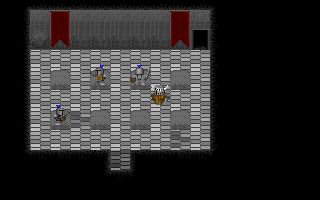
Which leads us to the batles themselves, which gracefully toe the line between challenge and tedium, depending on your fondness of levelbusting. Being an opponent of the practice, walking into it I found the game challenging enough to be just almost hard, the biggest challenge really just having enough money to afford equipment, something that becomes less of a problem if you take the Shilelah as reward for saving Lord Hasim. Most of the spells are varied and useful, though you will basically never need to use any of Bob's (his normal attack is usually enough and, depending on your weapon, possibly more beneficial). His special attacks are often few and far between, not to mention that I've always found the FF1-style magic cumbersome, always failing you just when you need it with its lack of available replenishing methods. All of the characters have very different attack styles, though in most cases save James, will carry on pretty successfully with only their regular attack. So perhaps there are balance issues, taking a lean toward "tedious" past Flanat Castle, though this doesn't necessarily make it subpar, it's just most games that approach battles conventionally all bore me eventually. Even so, the hero and monster designs are impressive enough to keep the battles interesting. The bosses past this point are much more challenging, especially the Archguardians mini-boss, where I found myself with only one Mage potion and wanting to conserve MP for the upcoming Broaste Ghost. And the closing fight with Jormundgandling, which plotwise is unbeatable, may actually be possible if equipped and prepared properly. I didn't quite approach it with that goal, but the possibility basically floored me.

There is, come to think of it, only one mini-game, the Pearl search, which is well-animated and a little hard to keep up with. If your eyes aren't fast enough, it's really just a kind've gambling game, the reward being for good guessing. It's also funny some of the little exploits you might find, like the Magical Regrowing Carrot just outside Flanat Village, which will reappear any time you have no Carrots in your inventory. It's an exploit that's great for bringing your health up when you're taking the riskier path to the castle, or, I'd imagine, when levelbusting. Another is, if you already know the Broaste Ghost is unbeatable the first time you fight him, you can run from the battle and save yourself the trouble of having to recover from 1 HP afterward. There's a lot of little tricks to this game you might pick up if you've played it enough. One of the biggest flaws is that aside from introducing you to a few possible and not necessarily even pertinent gameplay mechanics, the Plip Tamer really doesn't matter all that much or add to the total experience. He's kind've just there as optional beginning fluff. This is something that James is apparently considering for a revision, a move I'd definitely recommend.
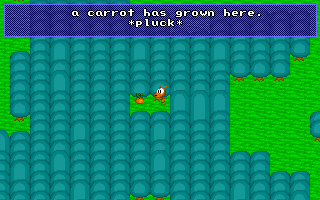
So, taking all these things into consideration, I'd say we've got a game that, even taken out of its basically inseparable historical context, is still worth it's chops, no matter what kind've landmark it is. You'll get a heavy dose of entertainment from the characters, in or out of battle. Wandering Hamster is really one of the most charming games on the engine, and I'd love to see it finished. Unfortunately it has been, as stated earlier, four years now since a release has moved the plot along at all, leaving players with so many questions. Why did Skeppio and Rathmara want to beat the Jormungandling? What's the deal with the potted cactus? Will Lord Hasim ever get a new carpet? But most importantly, perhaps...
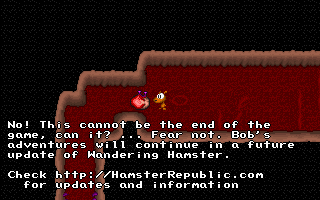
...Is this really the end for our intrepid hero?
Only time, perhaps, will tell.